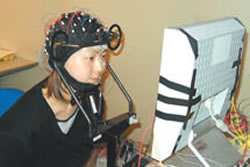
The current way that humans interact with computers is cumbersome and inefficient, due to the traditional input methods that are available to exchange information and data, mostly via keyboard and mouse. Today, people must still adapt to the constraints of the computer, and this is far from intuitive. Therefore, researchers speculate that EEG signals, or some other electrophysiological signals, might provide a new way to communicate with the external world and control remote devices and computers.
A brain-computer interface (BCI), or brain-machine interface (BMI), is a system that acquires and analyzes brain (neural) signals to create a high-bandwidth communications channel in real time between the brain and the computer. BCI research is an interdisciplinary endeavor involving neuroscience, engineering, and clinical rehabilitation, and lies at the intersection of several emerging technologies: Intelligent Simulators (IS), Information Autonomous Agents (IAA), Virtual Reality (VR) and Machine Learning (ML). BCI is now considered a new frontier in science and technology, especially in multimedia communication.
Two approaches, imagined stimulus-response and biofeedback, can be used to generate near-real-time information from detected changes in brain patterns. The former captures brain activation in different areas that emerges when an individual imagines an event in response to external cue. Biofeedback techniques, however, require individuals to generate signals that are interpreted by a computer or remote device by controlling aspects of his or her body such as relaxation and posture or to imagine doing rhythmic movements.
Encouraged by the growing understanding of brain functions and the development of new signal processing methods, our laboratory investigates the electrophysiological basis of BCIs to combine the approaches above. However, before EEG signals can be classified properly, they need to be well understood and suitably preprocessed. For example, using blind source separation (BSS) methods and time frequency representations, we can extract multi-modal brain signals by identifying key features and analyzing their patterns. In our experiments, high-density EEG sensor arrays record the electrical activity of the cortex with a high temporal resolution, in this way we attempt to distinguish complex mentally-activated brain sources for different types of tasks. We are particularly interested in the activation of the visual, auditory and motor cortices when the user attempts to control a program on a remote computer via BCI by concentrating and invoking specific tasks and mental imageries. We have used a variety of imagined stimuli, from visual shapes and acoustic tones to complex real-world images and sounds of letters, numbers, tropical beaches and limb movements. Another, entirely original BCI approach in our lab involves the mental activation of the cortical visual motion system, which is one of the most sensitive and well-developed sensory systems of the human brain.
Overall, BSS and information processing methods are very promising approaches for analysis of multi-sensory complex bio-systems. Of course, individual thoughts cannot yet be picked up and are probably far too complex for our purposes, so we focus on identifying those complex brain patterns related to various repetitive mental and imaginary tasks and to targeted auditory, visual and tactile stimuli.
To classify multi-sensory information, we are developing signal discriminators while simultaneously expanding our framework to include body-computer interactions because of unfavorable signal-to-noise ratios and insufficient EEG spatial resolutions. Using more general human computer interface (HCI) devices that integrate biofeedback from different aspects of the body, human commands can be conveyed to the computers not only by pre-processed brain signals but also by free speech, gaze- and head tracking, and gesture recognition. Such cross-modal systems are more flexible and adaptable to various handicaps and disorders.
Why is BCI, or more generally H/BCI, such an interesting and important subject for extensive research? The main reasons stem from potential contributions to new scientific and computer applications that:
- Develop human subject monitoring: Objective evaluations of job-related psychosomatic qualities (sensitivity, alertness, fatigue, attention), sleep disorders, neurological diseases, and emotions.
- Develop bioengineering devices: Develop devices to assist handicapped and elderly people.
- Provide a new research paradigm: Real-time correlations of observable tasks or behavior with recorded brain signals to learn how information from different sensory streams is integrated in the brain and use this knowledge to build efficient environment-conscious devices.
- Improve information agent systems: Working from the basis of: "Do what I mean (DWIM) not only what I say (NOWIS)", future computers may integrate more into daily routines (serving as an office assistant, multilingual travel guide, night watchman or video game partner when needed).
Expand possibilities for a human computer interface (HCI): An advanced human-computer interface can be more natural, flexible, efficient, secure, and user-friendly by enhancing the interaction between the brain, body, and computer. The development of a human-brain computer interface may take several years, but it has the potential to revolutionize multimedia communication and enhance our experiences of the world around us.






